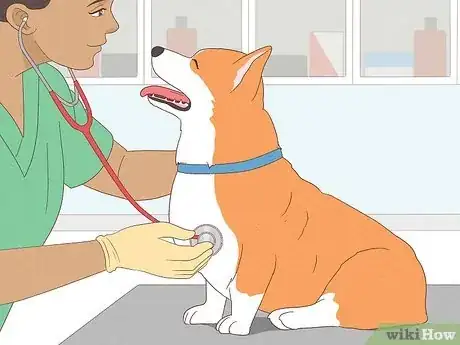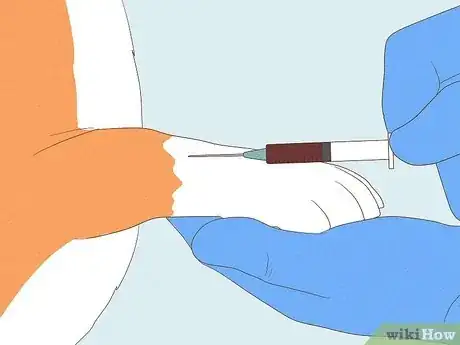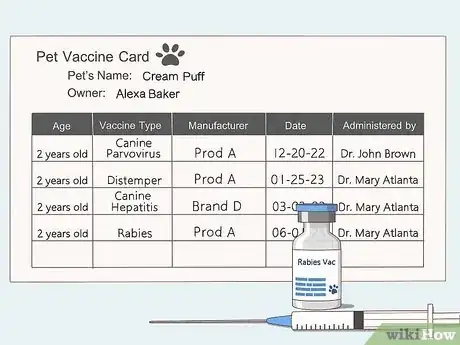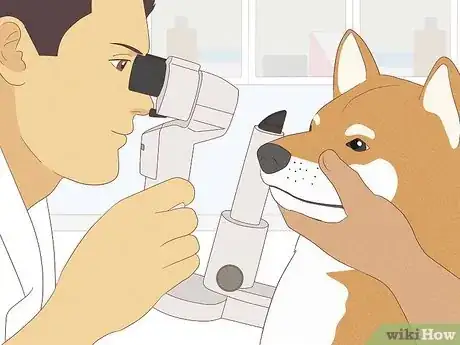This article was co-authored by Ryan Corrigan, LVT, VTS-EVN and by wikiHow staff writer, Hannah Madden. Ryan Corrigan is a Licensed Veterinary Technician in California. She received her Bachelor of Science in Veterinary Technology from Purdue University in 2010. She is also a Member of the Academy of Equine Veterinary Nursing Technicians since 2011.
There are 14 references cited in this article, which can be found at the bottom of the page.
This article has been viewed 28,565 times.
Making the decision to breed your dog is very exciting, and you’re probably anxious to get started right away. Performing pre-breeding health checks is one of the first steps in your dog-breeding journey. Not only do these checks ensure that your dog is healthy, but they also ensure that its puppies will be, too. In this article, we’ll tell you all of the pre-breeding health checks that are required, as well as any additional health checks you may have to do for your dog.
Steps
Pre-Breeding Veterinary Exam
-
1Have your vet perform a full physical exam. During this exam, your vet will check your dog from head to toe to make sure they’re healthy. Aspects of a complete physical exam include:[1]
- Listening to the heart and lungs
- Looking in the mouth
- Checking the eyes for glaucoma, lens changes, cataracts, or other genetic issues
- Examining the fur and skin
- Testing the range of motion in the joints
- Elbow grading
- Performing a vaginal exam to check for vaginal abnormalities (for female dogs only)
- Performing vaginal cytology to look at the cells in the vagina (for female dogs only)
-
2Let your vet take blood samples. Blood samples will tell your vet whether or not your dog has heartworm. Your vet will also most likely test your dog’s blood for brucellosis, a contagious disease that can cause infertility.[2]Advertisement
-
3Collect your dog’s stool for a fecal exam. Ask your vet if you need to collect your dog’s fecal matter before your visit. If you do, simply grab a stool sample from your dog and place it in the airtight container provided for you from your vet. Your vet will perform a fecal exam to test for intestinal worms.[4]
- Internal parasites can make your dog sick and/or unable to carry a pregnancy. The parasites could also get passed on to the puppies.
- Fortunately, you can treat intestinal worms in your dog. If your dog has intestinal worms, your vet will prescribe a medication called a dewormer that will kill the worms.
-
4Keep your dog up to date on its vaccines. Being up-to-date on vaccinations helps your dog stay healthy. While you are at the vet’s office for the physical exam, have your vet make sure your dog is current on all of its required vaccinations.[5]
- Vaccines for canine parvovirus, distemper, canine hepatitis, and rabies are common for most dogs.[6]
- If you aren’t sure if your dog is up to date or not, ask your vet to check their records.
Additional Health Checks
-
1Browse the specific health checks that your breed needs. Different dog breeds require different pre-breeding health checks. You can either ask your vet about which ones your dog needs, or you can look them up online. Check out which health checks your dog needs by entering their breed into the Canine Health Information Center’s website here: https://ofa.org/chic-programs/browse-by-breed/.
- Others may need a hip certification, either through the Orthopedic Foundation for Animals (OFA) or University of Pennsylvania Hip Improvement Plan (PennHip).
-
2Get your dog's eyes checked for a CERF certification. The goal of a Canine Eye Registration Foundation (CERF) certification is to detect genetic eye diseases that could cause blindness, such as cataracts. Ask your vet to do the check or have them refer you to a veterinary ophthalmologist who will perform the exam, then complete and submit an eye certification form.[7]
- After the exam, you can send the owner’s copy of the form to the OFA Eye Certification Registry.
- If your dog passed the CERF exam, meaning it’s free of genetic eye diseases, you will receive an official Eye Certification Registry certificate number.
- Because the CERF exam is a yearly exam, your dog’s eyes will need to be certified each year, even after it stops breeding.
- CERF exams are useful for most dogs, but some breed clubs do not endorse or value CERF exams, so it may be unnecessary.
-
3Get your dog’s hips evaluated if needed. Some dog breeds are predisposed to hip problems, which can disqualify them for breeding. The Orthopedic Foundation for Animals (OFA) test looks for signs of hip dysplasia, a genetic hip condition in dogs.[8] The University of Pennsylvania Hip Improvement Plan (PennHip) exam looks for looseness in the hip joints, which can lead to hip dysplasia.[9] Ask your vet to perform either one to check your dog’s hips before breeding.
- A hip evaluation involves taking multiple x-rays of the hips. To do this, your dog may be sedated.
- The PennHip test, which can be performed in dogs as young as 4 months old, is performed by a PennHip-certified vet.
- A dog must be at least 2 years old for the OFA hip evaluation. The hip x-rays will be sent to the OFA, which will evaluate the x-rays and determine the health of your dog’s hips.
- Typically, hip evaluations are done in larger dog breeds that are predisposed to hip issues. The vet will perform “hip scoring,” and give their hips a number on a scale from 0 to 106.[10]
-
4Discuss the need for genetic testing with your vet. Your dog’s breed may be prone to certain genetic diseases. Talk with a knowledgeable breeder and your vet to learn about breed-specific genetic diseases. Then, decide whether to have genetic testing performed.[11]
- To find out more information about your dog’s genetic testing recommendations, search for their breed on The Kennel Club’s website.
General Pre-Breeding Tips
-
1Set aside money and time to breed your dog. Breeding a dog is a serious undertaking. In addition to making sure your dog is healthy, you should be sure you’re ready to take on the responsibility of dog breeding. Consider these questions:[12]
- Will your dog contribute to the improvement of the breed?
- Do you have money set aside for emergency veterinary care?
- Are you knowledgeable about what’s involved in a dog pregnancy, including whelping (giving birth) and raising newborn puppies?
- Do you know about your dog breed’s genetic diseases?
- Would you be willing to take the puppies back if an owner decides it doesn’t want them?
- Can you make yourself or another adult available 24 hours a day after the mother dog gives birth?
-
2Wait for your dog to mature before breeding it. Male dogs reach full sexual maturity by 12 to 15 months of age. Female dogs have their first menstrual cycle anywhere from 6 to 24 months of age. If you’re breeding a female dog, wait until after its first cycle to ensure it’s ready for pregnancy.[13]
- Ideally, a female dog should not be bred until it’s at least 2 years old and has had 2 or 3 menstrual cycles.[14]
- Breeding your dog too soon can lead to problems, especially if they aren’t physically able to breed yet. Breeding a female dog too early could mean they aren’t ready to handle pregnancy, which can cause health issues.
-
3Keep your dog healthy. In addition to pre-breeding health checks, try to keep your dog as healthy as possible overall. There are a few things you can do to keep your dog healthy before breeding them, including:[15]
- Feeding your dog a healthy diet.
- Exercising your dog every day.
- Taking your dog to your vet for regular wellness exams.
References
- ↑ https://www.bmdca.org/health/tests.php
- ↑ https://www.akc.org/expert-advice/health/brucellosis-dog-breeders-shouldnt-skip-testing-for-this-dangerous-disease/
- ↑ https://vcahospitals.com/know-your-pet/canine-brucellosis
- ↑ https://vcahospitals.com/know-your-pet/routine-fecal-testing-faqs-for-dog-owners
- ↑ https://wsava.org/wp-content/uploads/2020/01/WSAVA-Owner-Breeder-Guidelines-2015_1.pdf
- ↑ https://www.aspca.org/pet-care/general-pet-care/vaccinations-your-pet
- ↑ https://ofa.org/diseases/eye-disease/
- ↑ https://ofa.org/diseases/hip-dysplasia/
- ↑ https://www.vet.upenn.edu/about/news-room/bellwether/bellwether-magazine/bellwether-winter-2015/pennhip-article
- ↑ https://www.thekennelclub.org.uk/health-and-dog-care/health/getting-started-with-health-testing-and-screening/hip-dysplasia-screening-scheme/
- ↑ https://www.thekennelclub.org.uk/health-and-dog-care/health/getting-started-with-health-testing-and-screening/
- ↑ https://www.akc.org/expert-advice/dog-breeding/should-i-breed-my-dog/
- ↑ https://www.akc.org/breeder-programs/breeder-education/akcs-guide-responsible-dog-breeding/
- ↑ https://vcahospitals.com/know-your-pet/breeding-for-pet-owners-estrus-and-mating-in-dogs
- ↑ https://www.akc.org/breeder-programs/breeder-education/akcs-guide-responsible-dog-breeding/






































































